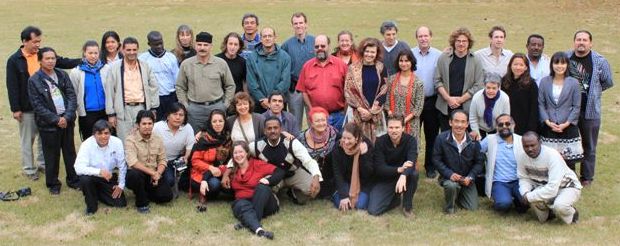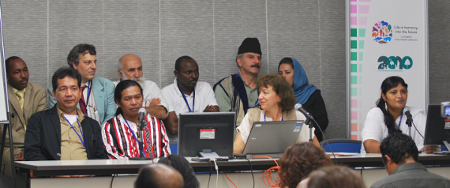First published on 10/31/2010, and last updated on 07/19/2022
The tenth Conference of the Parties (COP 10) of the Convention on Biological Diversity (CBD) held in the second half of October 2010 in Nagoya (Japan) reaffirmed and strengthened the centrality of governance of protected areas and the recognition and support to ICCAs and sacred sites. Follow this link to read more on ICCAs in Decisions of CBD COP 10.
The Conference discussed and approved a number of major policy documents, including an in depth review of the implementation of the Programme of Work on Protected Areas (PoWPA), which will guide CBD work on protected areas for the next decade. Some agreed wordings are clear and undoubtedly positive (see below). Others still fall short of advancing meaningful change. And some last minutes alterations brought us some sincere disappointment. In all, however, the picture is encouraging even if, as usual… much work simply lies ahead.The members and partners of the ICCA Consortium have been gearing up and assisting for this “encouraging picture” for a number of years. From Durban’s Vth World Parks Congress to COP 7, COP 8, COP 9 and other dedicated CBD meetings, we closely accompanied preparation, development, refinement and evaluations of PoWPA. Most recently, we actively participated in the SBSTTA meeting in Nairobi (May 2010) where the draft decision documents for COP 10 were developed. In addition, we volunteered technical support for the preliminary training on protected area governance held in 2009 at all four PoWPA Regional Review meetings (Ivory Coast, India, Colombia and Germany). Mentioning only recent documents, we co-produced IUCN/CEESP Briefing Note no. 8, no. 9 and no. 10 on issues of governance of protected areas and ICCAs specifically addressing CBD delegates and advisors. In Nagoya, the ICCA Consortium organised its first large General Assembly and co-organised two side events at COP 10, one focusing on ICCAs in terrestrial environments and the other on ICCAs in marine and coastal environments. The side event were very well attended and lively and provided an occasion to launch the new publication Bio-cultural diversity conserved by indigenous peoples and local communities: examples and analysis – a 72-page document produced in English, Spanish and French (see the publication page). We also co-organised a three-day ICCA workshop, which was held in Shirakawa at the end of COP 10.

International ICCA Workshop, Shirakawa (Japan), in the occasion of CBD COP 10
To be honest, we could have done more. Had we been more focused and active we could have possibly achieved the word changes we really hoped for regarding a more effective involvement of indigenous peoples and local communities in reporting about PoWPA. And we could have been more prepared to counteract the last-instant modifications proposed by the delegate of New Zealand who erased the invitation to CBD Parties to “respect the customary governance systems that have maintained ICCAs over time”. We feel deeply frustrated about that, but the learning is important. We now know that we must – next time— work more closely with several country delegations and simply sit next to them at the time of discussing specific wordings… including those that are not bracketed and passed all scrutinises up to the last!
The wordings on the main approved document are important. Parties are invited to “Recognize the role of indigenous and local community conserved areas…”; “Improve and, where necessary, diversify and strengthen protected-area governance types…”; “Recognize the contribution of […] indigenous and local community conserved areas within the national protected area system through acknowledgement in national legislation or other effective means”;” Establish effective processes for the full and effective participation of indigenous and local communities, in full respect of their rights and recognition of their responsibilities, in the governance of protected areas…”;”Further develop and implement measures for the equitable sharing of both costs and benefits arising from the establishment and management of protected areas…”; “Include indigenous and local communities in multi-stakeholder advisory committees, in consultations for national reporting on the programme of work on protected areas, and in national reviews of the effectiveness of protected area system”. Furthermore, Parties are encouraged to carry out assessments of the governance of their protected areas using toolkits prepared by the CBD Secretariat. We are already actively assisting in that work, which is currently led by CEESP member Neema Pathak of Kalpavriksh, India (one of the key organisations members of the ICCA Consortium). And the ICCA Consortium will collaborate with the IUCN Global protected areas programme to develop technical guidance on governance of protected areas, to assist directly in capacity building at regional and sub-regional level and to plan ahead for the 6th World Parks Congress of 2014.
Of less straightforward interpretation is the main new global target for protected areas approved also in Nagoya as part of the post-2010 Strategic Plan: “By 2020, at least 17 per cent of terrestrial and inland water, and 10 per cent of coastal and marine areas, especially areas of particular importance for biodiversity and ecosystem services, are conserved through effectively and equitably managed, ecologically representative and well connected systems of protected areas and other effective area-based conservation measures, and integrated into the wider landscape and seascapes.” A target of “17% of areas of particular importance for biodiversity and ecosystem services” is a clear improvement compared with the more timid and less muscled “10 percent of each biome” recommended by the Fourth World Parks Congress (Caracas, 1992). It is a bit worrying that countries are encouraged to expand protected area coverage without the necessary attention to governance issues (types and quality), but it is positive that they are also to take advantage of “other effective area-based conservation measures”. The latter may well include ICCAs that indigenous peoples and local communities prefer to maintain outside national protected areas systems for a variety of reasons, a topic for which the ICCA Consortium can usefully further collaborate with the CBD Secretariat. During the Nagoya discussions we proposed that “equitably governed” is substituted for “equitably managed” in the protected area target… with the benefit of saying something of clearer meaning. As the very word equity had been hotly questioned, however, even delegates who very much favoured the proposed change chose not to disturb an equilibrium that had been achieved with difficulty.
The wordings of CBD decision documents are not all that remain of such large events. Beyond the wordings, it is the “broadly accepted understanding of ideas and concepts” that makes or breaks the evolution in perspective and action important for our work, the broader political and cultural meaning of what we attempt to achieve… In this sense two aspects of the corridor debates appear quite relevant. The first aspect is that “governance” and “ICCAs” have now moved from novelties to accepted concepts in the conservation arena. This is nothing less than a feat to celebrate, considering how central governance is for the respect of human rights and the rights of indigenous peoples in conservation. Let me stress that we are no longer talking in terms of access to resources or tenure rights, as important as they are for the livelihoods of people. We are talking about governance, i.e. who and how should decide about such access and tenure, and much else. Who, in fact, has the right to decide? How should that right be exercised? Governance is a master door through which the fundamental issues of power are looked at straight in the eyes. The second aspect is that a new front of debate has opened facing conservationists, economists and politicians currently very busy attaching a price tag to virtually everything of value. With the economic valuation of ecosystem services, the exchange of “access” (for business) for “benefit sharing” (for communities), and the invention of a plethora of mechanisms that move money around with the excuse of responding to climate change, the market place is expanding to cover the forests, the valleys, the oceans, the mountains, the atmosphere and the consciousness of everyone. This is a dangerous happening, only barely contrasted by the resurgent interest in the commons and their shared, non-monetary values. Why dangerous? There are several reasons, but possibly the most evident is that, in a world of ever-widening differences in economic power, price tags that are irrelevant for some become irresistible for others. An empowering reply for the weaker actors in society may be to refuse such tags altogether…
